BM522 Project Management: Road Improvement Plan for TfL London
VerifiedAdded on 2023/06/18
|17
|2632
|419
Case Study
AI Summary
This document presents a comprehensive project management plan for Transport for London's (TfL) road improvement initiative, aimed at creating safer, greener, and more attractive streets in London. The project, spanning from September 27, 2021, to November 12, 2021, incorporates methodologies such as Agile and Waterfall to efficiently manage operations and involve stakeholders. Key components include a network diagram illustrating project activities and timelines, a stakeholder analysis identifying and prioritizing key stakeholders, a Work Breakdown Structure (WBS) for task management, and a risk analysis assessing potential threats and mitigation strategies. The plan also addresses quality control measures to ensure the highest standards are met throughout the project lifecycle. This project management plan provides a structured approach to achieving TfL's objectives while minimizing risks and maximizing efficiency.
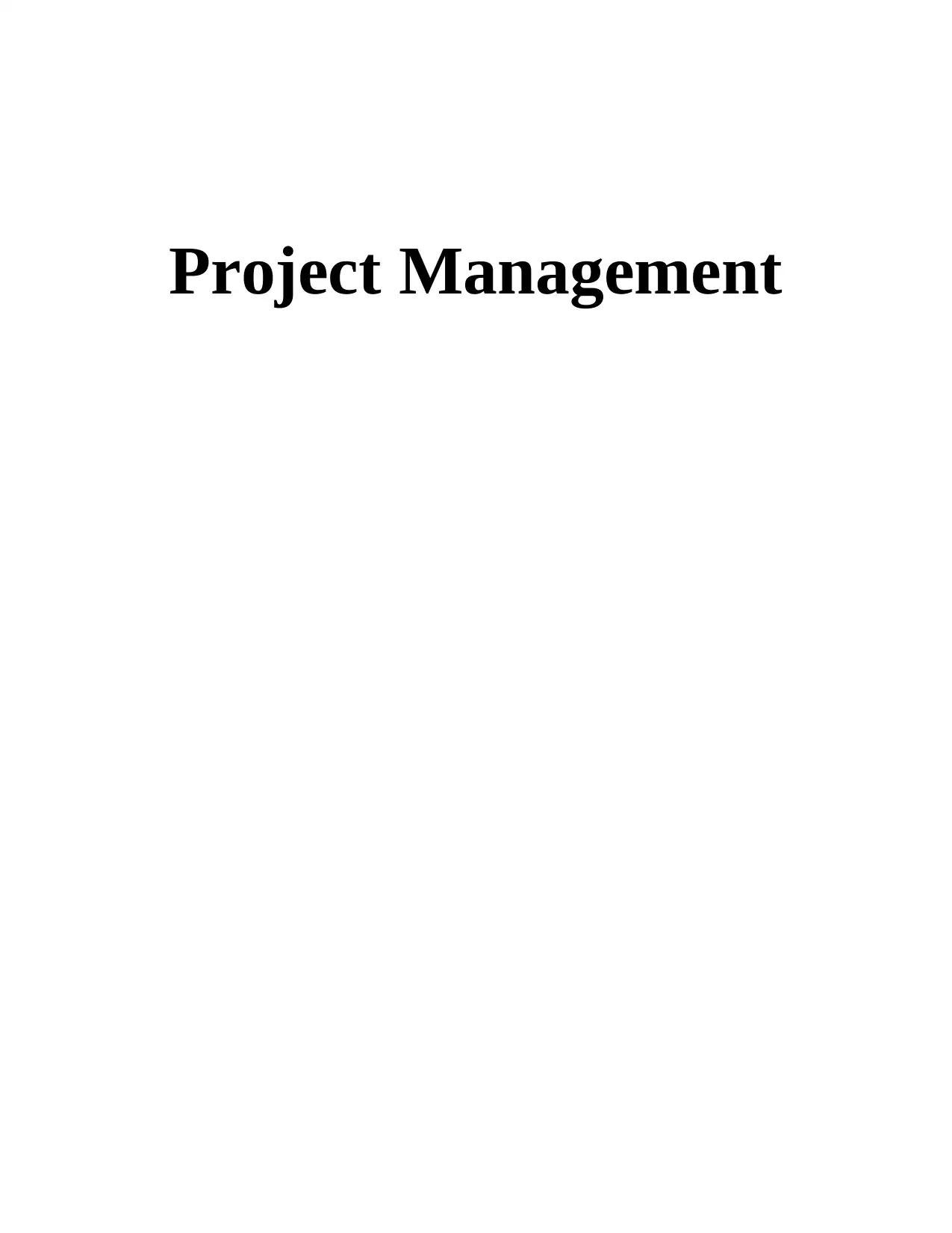
Project Management
Paraphrase This Document
Need a fresh take? Get an instant paraphrase of this document with our AI Paraphraser

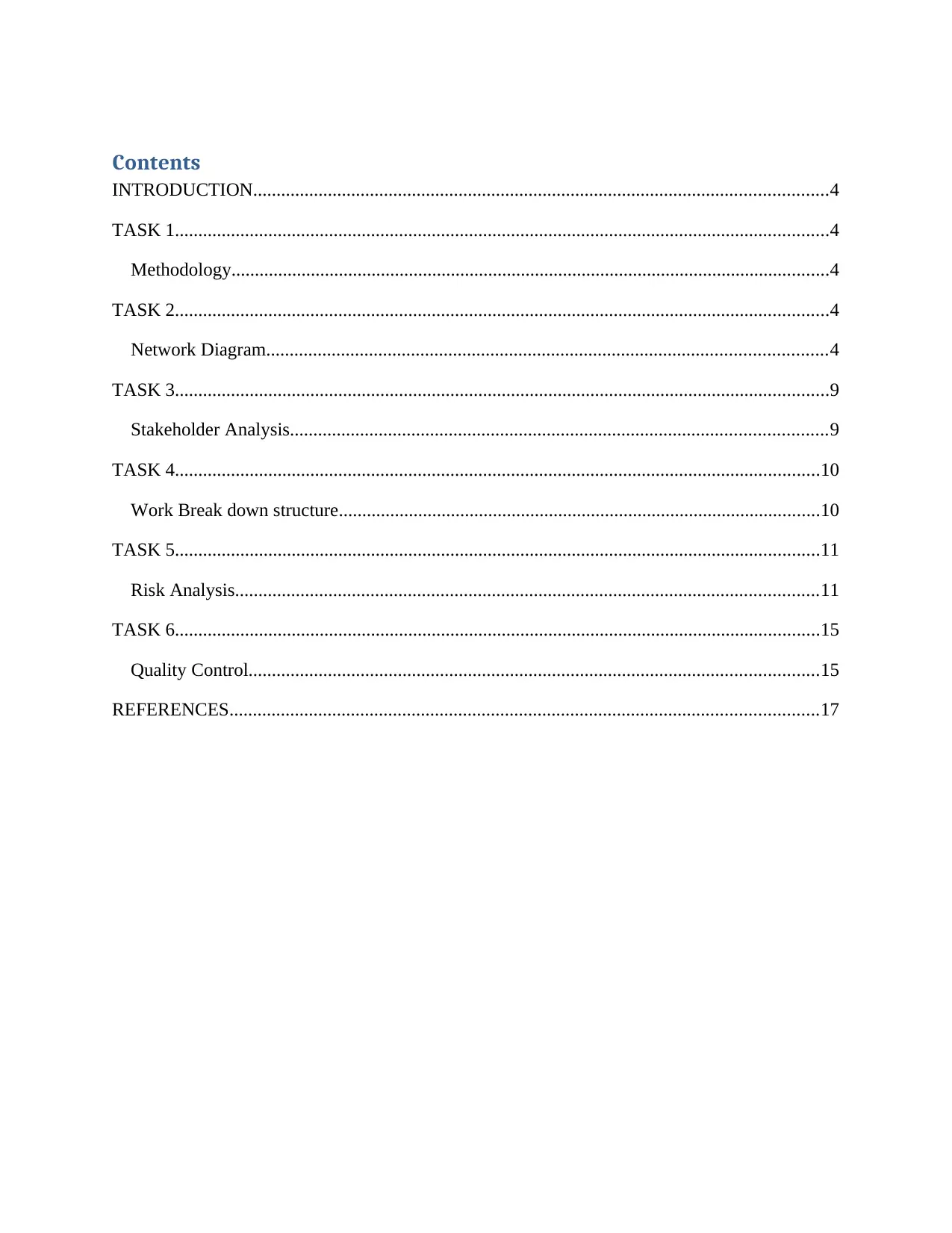
Contents
INTRODUCTION...........................................................................................................................4
TASK 1............................................................................................................................................4
Methodology................................................................................................................................4
TASK 2............................................................................................................................................4
Network Diagram........................................................................................................................4
TASK 3............................................................................................................................................9
Stakeholder Analysis...................................................................................................................9
TASK 4..........................................................................................................................................10
Work Break down structure.......................................................................................................10
TASK 5..........................................................................................................................................11
Risk Analysis.............................................................................................................................11
TASK 6..........................................................................................................................................15
Quality Control..........................................................................................................................15
REFERENCES..............................................................................................................................17
INTRODUCTION...........................................................................................................................4
TASK 1............................................................................................................................................4
Methodology................................................................................................................................4
TASK 2............................................................................................................................................4
Network Diagram........................................................................................................................4
TASK 3............................................................................................................................................9
Stakeholder Analysis...................................................................................................................9
TASK 4..........................................................................................................................................10
Work Break down structure.......................................................................................................10
TASK 5..........................................................................................................................................11
Risk Analysis.............................................................................................................................11
TASK 6..........................................................................................................................................15
Quality Control..........................................................................................................................15
REFERENCES..............................................................................................................................17
⊘ This is a preview!⊘
Do you want full access?
Subscribe today to unlock all pages.

Trusted by 1+ million students worldwide
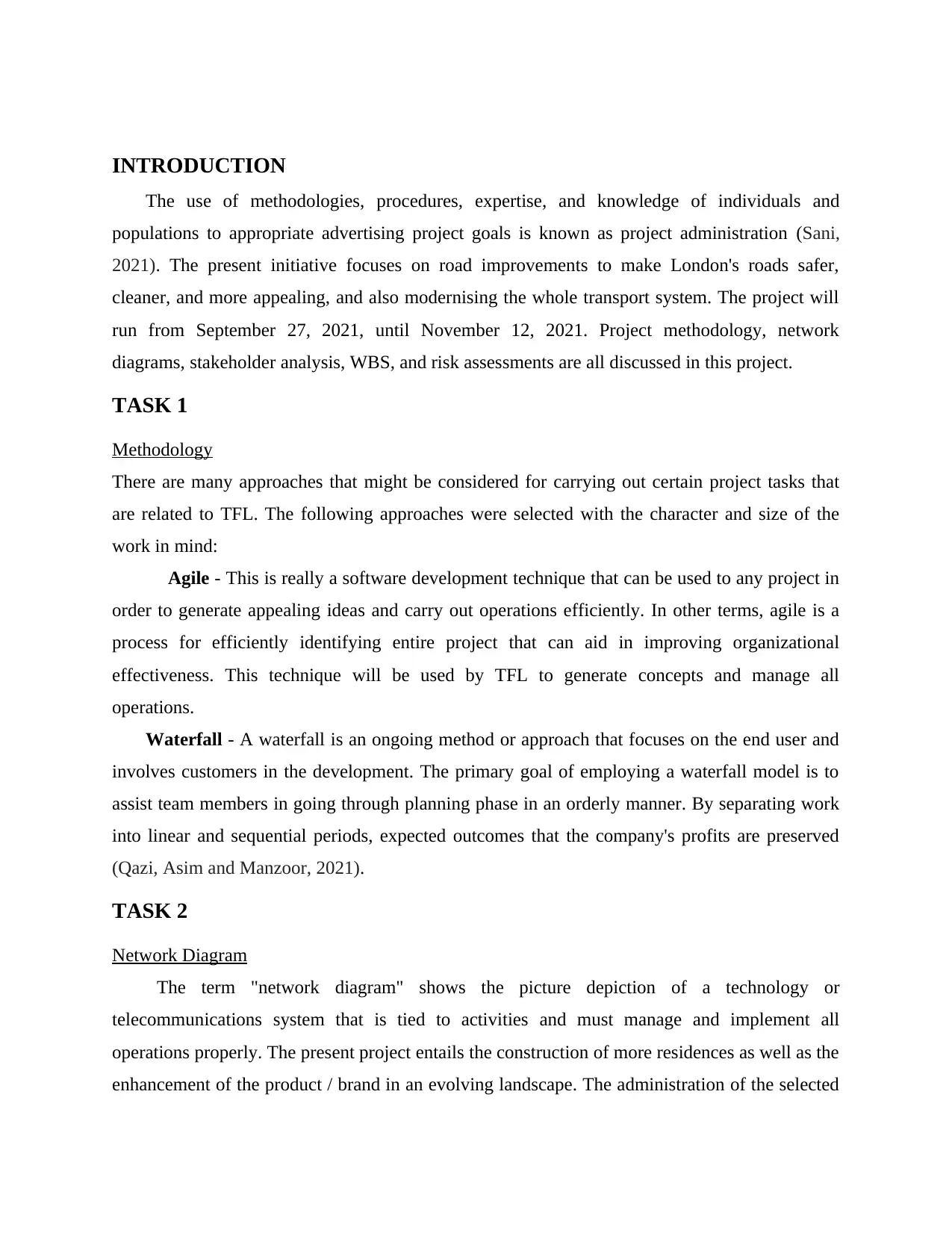
INTRODUCTION
The use of methodologies, procedures, expertise, and knowledge of individuals and
populations to appropriate advertising project goals is known as project administration (Sani,
2021). The present initiative focuses on road improvements to make London's roads safer,
cleaner, and more appealing, and also modernising the whole transport system. The project will
run from September 27, 2021, until November 12, 2021. Project methodology, network
diagrams, stakeholder analysis, WBS, and risk assessments are all discussed in this project.
TASK 1
Methodology
There are many approaches that might be considered for carrying out certain project tasks that
are related to TFL. The following approaches were selected with the character and size of the
work in mind:
Agile - This is really a software development technique that can be used to any project in
order to generate appealing ideas and carry out operations efficiently. In other terms, agile is a
process for efficiently identifying entire project that can aid in improving organizational
effectiveness. This technique will be used by TFL to generate concepts and manage all
operations.
Waterfall - A waterfall is an ongoing method or approach that focuses on the end user and
involves customers in the development. The primary goal of employing a waterfall model is to
assist team members in going through planning phase in an orderly manner. By separating work
into linear and sequential periods, expected outcomes that the company's profits are preserved
(Qazi, Asim and Manzoor, 2021).
TASK 2
Network Diagram
The term "network diagram" shows the picture depiction of a technology or
telecommunications system that is tied to activities and must manage and implement all
operations properly. The present project entails the construction of more residences as well as the
enhancement of the product / brand in an evolving landscape. The administration of the selected
The use of methodologies, procedures, expertise, and knowledge of individuals and
populations to appropriate advertising project goals is known as project administration (Sani,
2021). The present initiative focuses on road improvements to make London's roads safer,
cleaner, and more appealing, and also modernising the whole transport system. The project will
run from September 27, 2021, until November 12, 2021. Project methodology, network
diagrams, stakeholder analysis, WBS, and risk assessments are all discussed in this project.
TASK 1
Methodology
There are many approaches that might be considered for carrying out certain project tasks that
are related to TFL. The following approaches were selected with the character and size of the
work in mind:
Agile - This is really a software development technique that can be used to any project in
order to generate appealing ideas and carry out operations efficiently. In other terms, agile is a
process for efficiently identifying entire project that can aid in improving organizational
effectiveness. This technique will be used by TFL to generate concepts and manage all
operations.
Waterfall - A waterfall is an ongoing method or approach that focuses on the end user and
involves customers in the development. The primary goal of employing a waterfall model is to
assist team members in going through planning phase in an orderly manner. By separating work
into linear and sequential periods, expected outcomes that the company's profits are preserved
(Qazi, Asim and Manzoor, 2021).
TASK 2
Network Diagram
The term "network diagram" shows the picture depiction of a technology or
telecommunications system that is tied to activities and must manage and implement all
operations properly. The present project entails the construction of more residences as well as the
enhancement of the product / brand in an evolving landscape. The administration of the selected
Paraphrase This Document
Need a fresh take? Get an instant paraphrase of this document with our AI Paraphraser
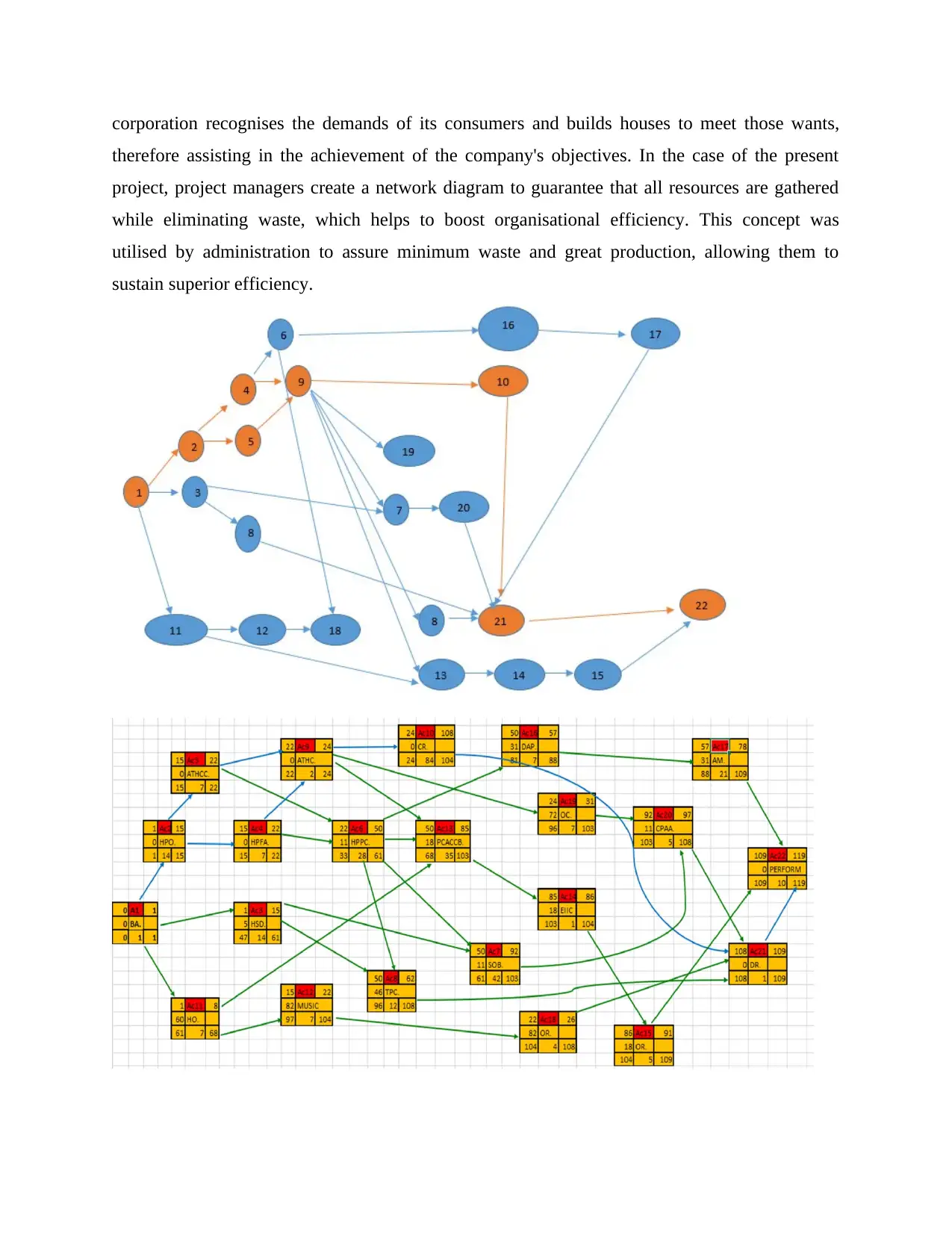
corporation recognises the demands of its consumers and builds houses to meet those wants,
therefore assisting in the achievement of the company's objectives. In the case of the present
project, project managers create a network diagram to guarantee that all resources are gathered
while eliminating waste, which helps to boost organisational efficiency. This concept was
utilised by administration to assure minimum waste and great production, allowing them to
sustain superior efficiency.
therefore assisting in the achievement of the company's objectives. In the case of the present
project, project managers create a network diagram to guarantee that all resources are gathered
while eliminating waste, which helps to boost organisational efficiency. This concept was
utilised by administration to assure minimum waste and great production, allowing them to
sustain superior efficiency.
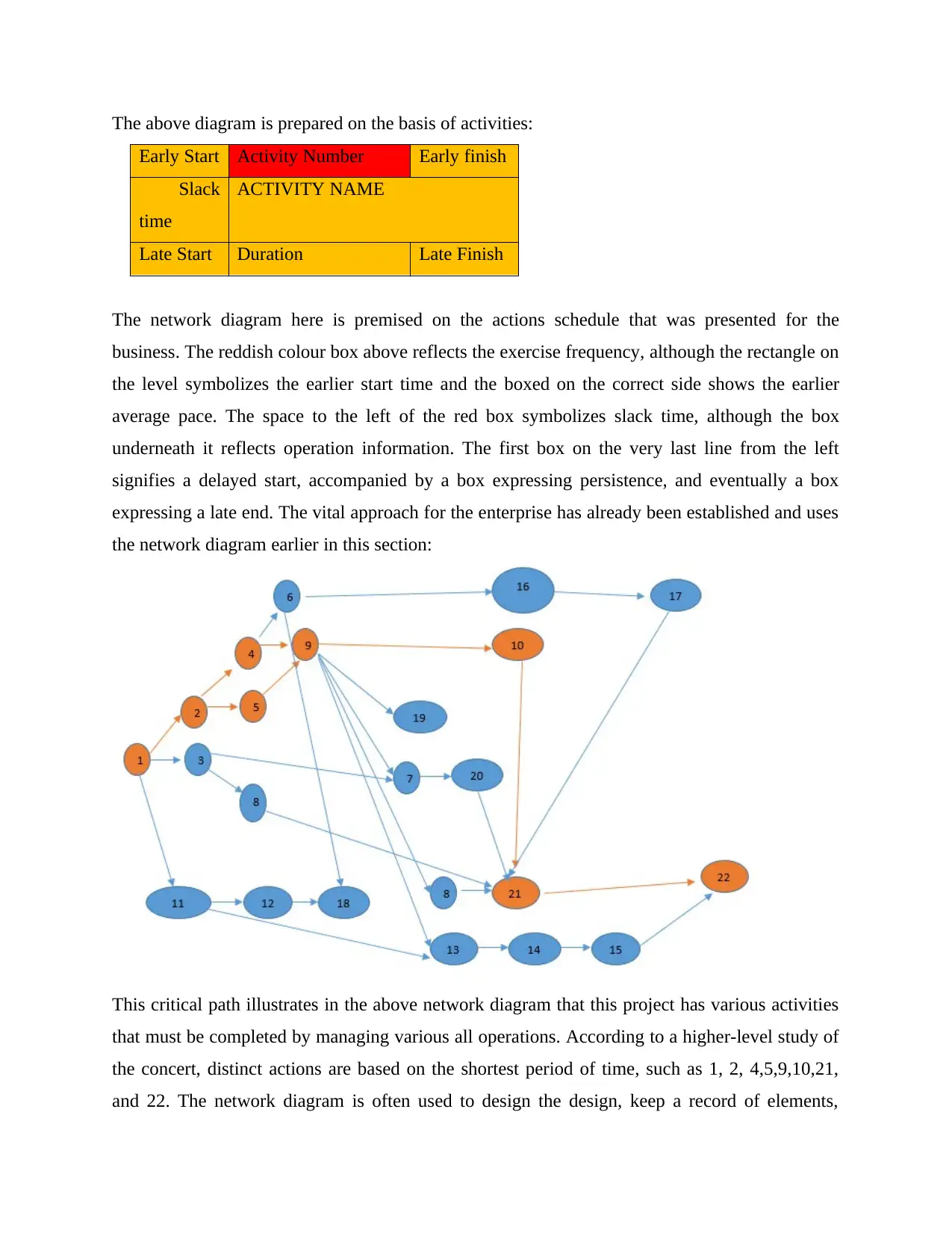
The above diagram is prepared on the basis of activities:
Early Start Activity Number Early finish
Slack
time
ACTIVITY NAME
Late Start Duration Late Finish
The network diagram here is premised on the actions schedule that was presented for the
business. The reddish colour box above reflects the exercise frequency, although the rectangle on
the level symbolizes the earlier start time and the boxed on the correct side shows the earlier
average pace. The space to the left of the red box symbolizes slack time, although the box
underneath it reflects operation information. The first box on the very last line from the left
signifies a delayed start, accompanied by a box expressing persistence, and eventually a box
expressing a late end. The vital approach for the enterprise has already been established and uses
the network diagram earlier in this section:
This critical path illustrates in the above network diagram that this project has various activities
that must be completed by managing various all operations. According to a higher-level study of
the concert, distinct actions are based on the shortest period of time, such as 1, 2, 4,5,9,10,21,
and 22. The network diagram is often used to design the design, keep a record of elements,
Early Start Activity Number Early finish
Slack
time
ACTIVITY NAME
Late Start Duration Late Finish
The network diagram here is premised on the actions schedule that was presented for the
business. The reddish colour box above reflects the exercise frequency, although the rectangle on
the level symbolizes the earlier start time and the boxed on the correct side shows the earlier
average pace. The space to the left of the red box symbolizes slack time, although the box
underneath it reflects operation information. The first box on the very last line from the left
signifies a delayed start, accompanied by a box expressing persistence, and eventually a box
expressing a late end. The vital approach for the enterprise has already been established and uses
the network diagram earlier in this section:
This critical path illustrates in the above network diagram that this project has various activities
that must be completed by managing various all operations. According to a higher-level study of
the concert, distinct actions are based on the shortest period of time, such as 1, 2, 4,5,9,10,21,
and 22. The network diagram is often used to design the design, keep a record of elements,
⊘ This is a preview!⊘
Do you want full access?
Subscribe today to unlock all pages.

Trusted by 1+ million students worldwide
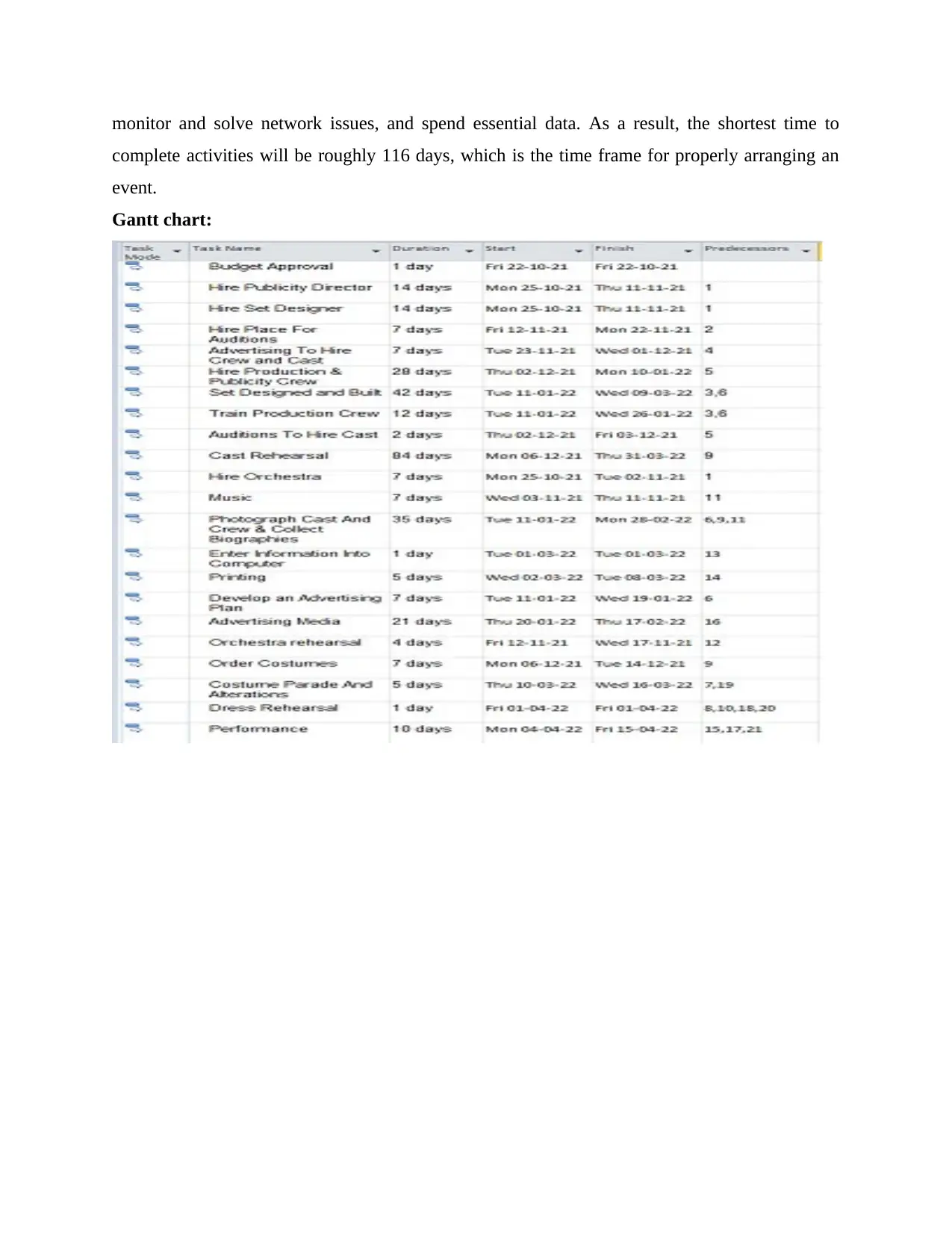
monitor and solve network issues, and spend essential data. As a result, the shortest time to
complete activities will be roughly 116 days, which is the time frame for properly arranging an
event.
Gantt chart:
complete activities will be roughly 116 days, which is the time frame for properly arranging an
event.
Gantt chart:
Paraphrase This Document
Need a fresh take? Get an instant paraphrase of this document with our AI Paraphraser
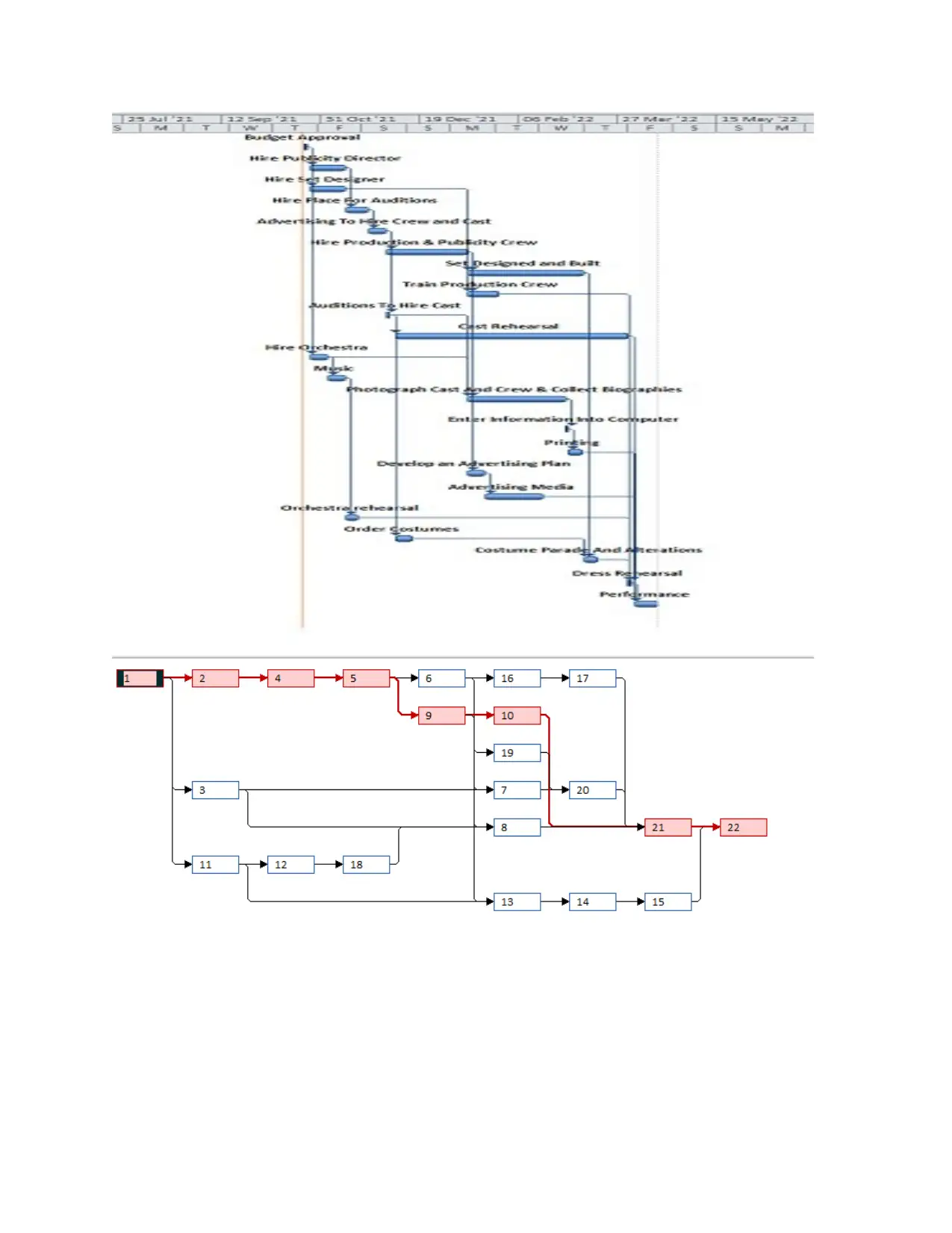
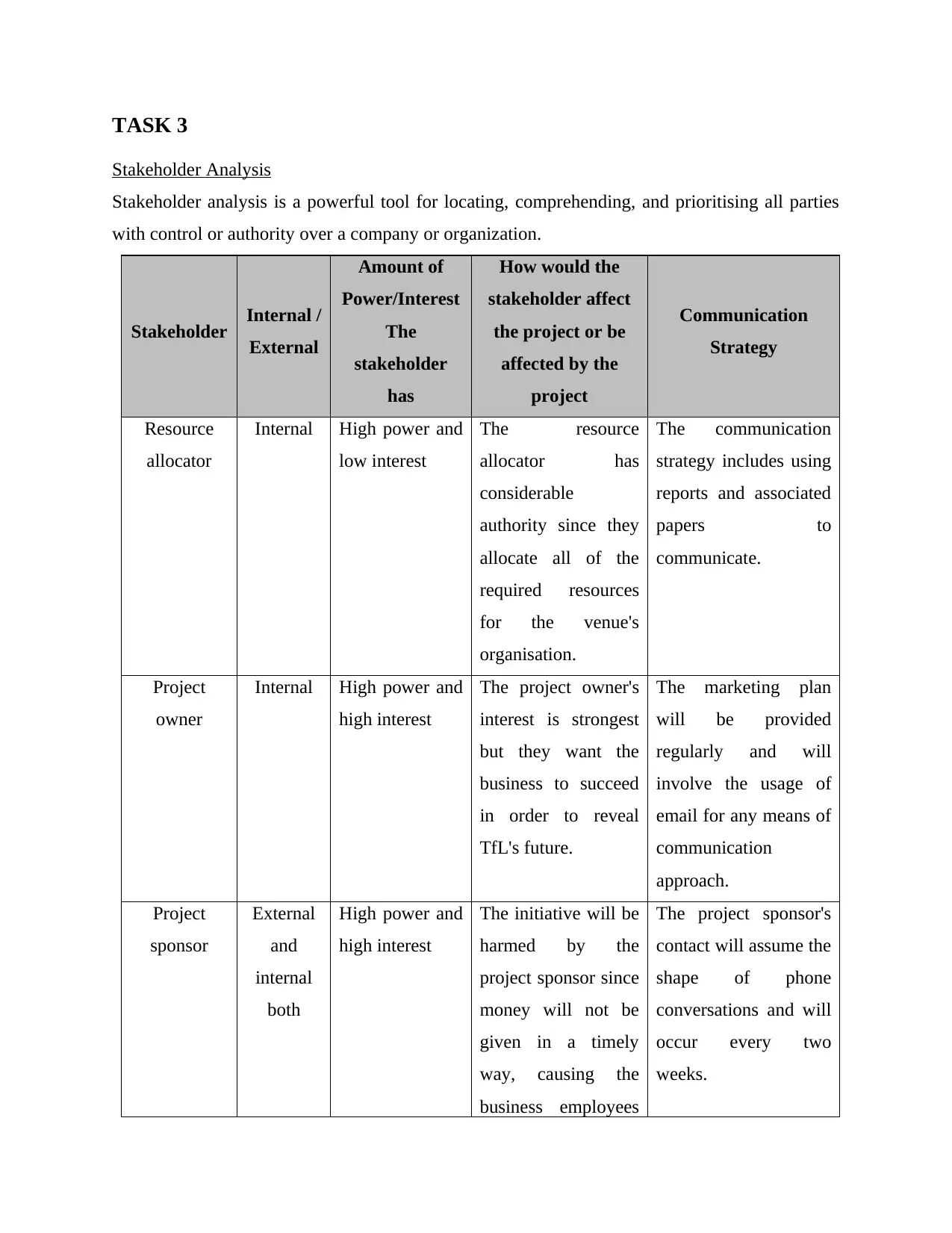
TASK 3
Stakeholder Analysis
Stakeholder analysis is a powerful tool for locating, comprehending, and prioritising all parties
with control or authority over a company or organization.
Stakeholder Internal /
External
Amount of
Power/Interest
The
stakeholder
has
How would the
stakeholder affect
the project or be
affected by the
project
Communication
Strategy
Resource
allocator
Internal High power and
low interest
The resource
allocator has
considerable
authority since they
allocate all of the
required resources
for the venue's
organisation.
The communication
strategy includes using
reports and associated
papers to
communicate.
Project
owner
Internal High power and
high interest
The project owner's
interest is strongest
but they want the
business to succeed
in order to reveal
TfL's future.
The marketing plan
will be provided
regularly and will
involve the usage of
email for any means of
communication
approach.
Project
sponsor
External
and
internal
both
High power and
high interest
The initiative will be
harmed by the
project sponsor since
money will not be
given in a timely
way, causing the
business employees
The project sponsor's
contact will assume the
shape of phone
conversations and will
occur every two
weeks.
Stakeholder Analysis
Stakeholder analysis is a powerful tool for locating, comprehending, and prioritising all parties
with control or authority over a company or organization.
Stakeholder Internal /
External
Amount of
Power/Interest
The
stakeholder
has
How would the
stakeholder affect
the project or be
affected by the
project
Communication
Strategy
Resource
allocator
Internal High power and
low interest
The resource
allocator has
considerable
authority since they
allocate all of the
required resources
for the venue's
organisation.
The communication
strategy includes using
reports and associated
papers to
communicate.
Project
owner
Internal High power and
high interest
The project owner's
interest is strongest
but they want the
business to succeed
in order to reveal
TfL's future.
The marketing plan
will be provided
regularly and will
involve the usage of
email for any means of
communication
approach.
Project
sponsor
External
and
internal
both
High power and
high interest
The initiative will be
harmed by the
project sponsor since
money will not be
given in a timely
way, causing the
business employees
The project sponsor's
contact will assume the
shape of phone
conversations and will
occur every two
weeks.
⊘ This is a preview!⊘
Do you want full access?
Subscribe today to unlock all pages.

Trusted by 1+ million students worldwide
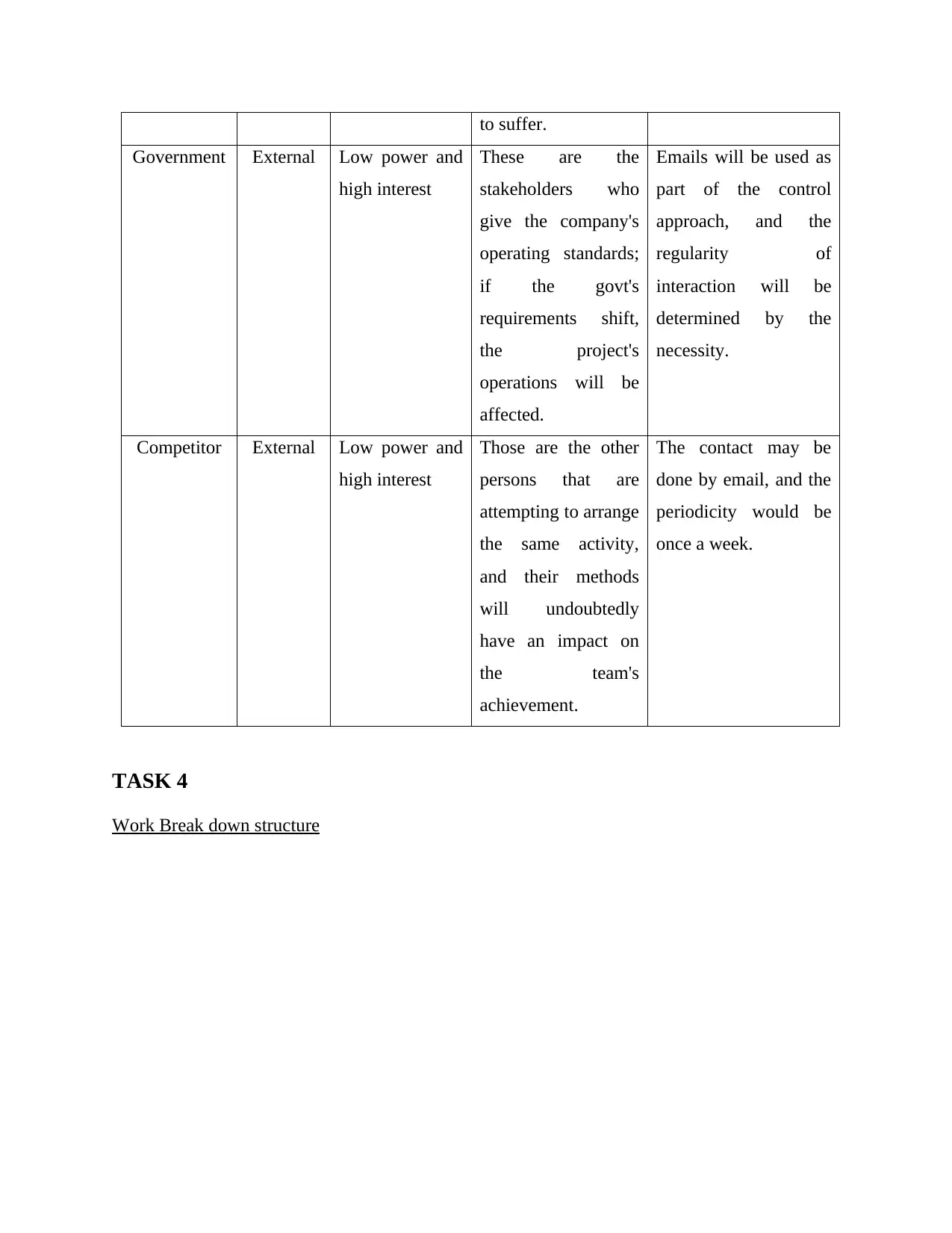
to suffer.
Government External Low power and
high interest
These are the
stakeholders who
give the company's
operating standards;
if the govt's
requirements shift,
the project's
operations will be
affected.
Emails will be used as
part of the control
approach, and the
regularity of
interaction will be
determined by the
necessity.
Competitor External Low power and
high interest
Those are the other
persons that are
attempting to arrange
the same activity,
and their methods
will undoubtedly
have an impact on
the team's
achievement.
The contact may be
done by email, and the
periodicity would be
once a week.
TASK 4
Work Break down structure
Government External Low power and
high interest
These are the
stakeholders who
give the company's
operating standards;
if the govt's
requirements shift,
the project's
operations will be
affected.
Emails will be used as
part of the control
approach, and the
regularity of
interaction will be
determined by the
necessity.
Competitor External Low power and
high interest
Those are the other
persons that are
attempting to arrange
the same activity,
and their methods
will undoubtedly
have an impact on
the team's
achievement.
The contact may be
done by email, and the
periodicity would be
once a week.
TASK 4
Work Break down structure
Paraphrase This Document
Need a fresh take? Get an instant paraphrase of this document with our AI Paraphraser
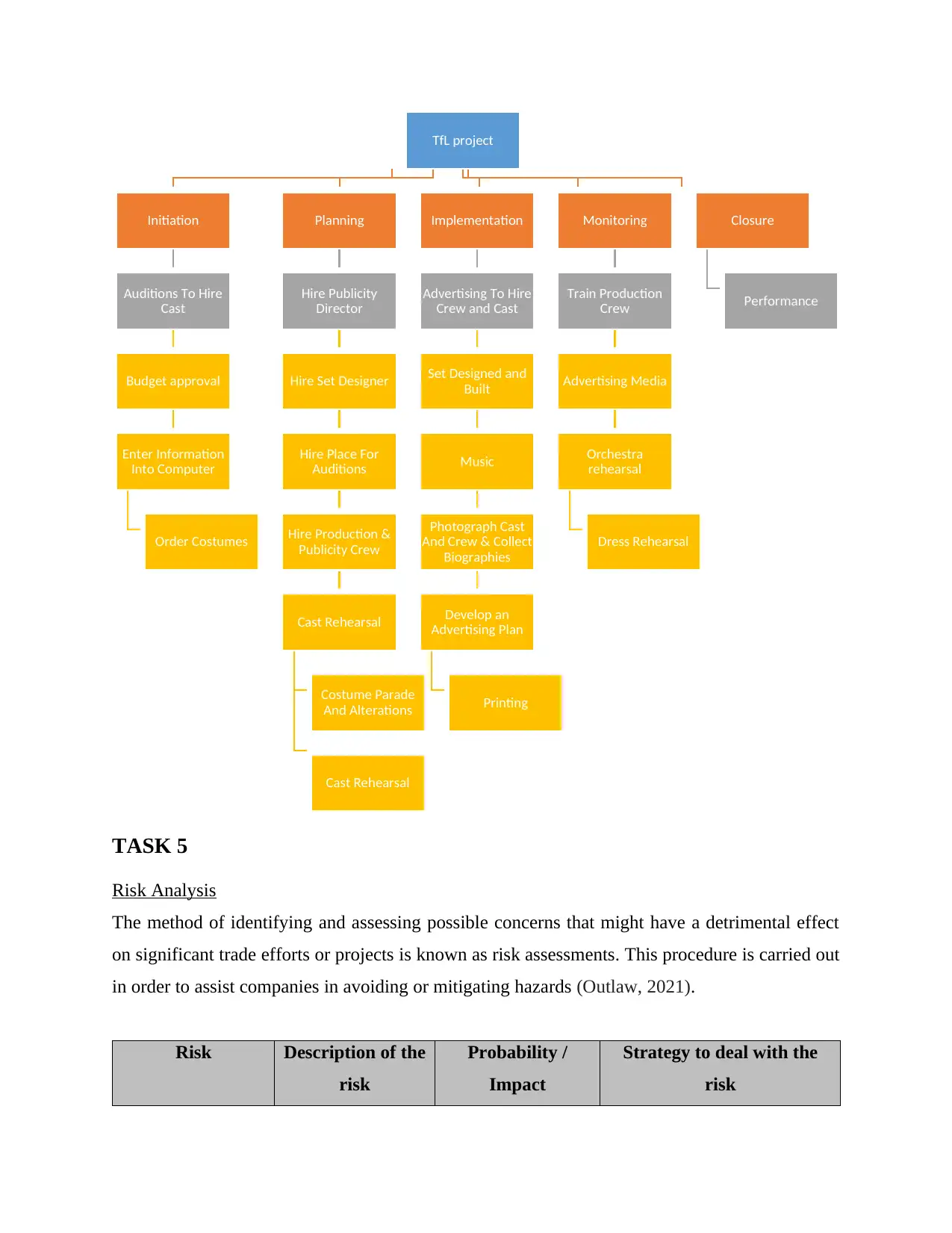
TASK 5
Risk Analysis
The method of identifying and assessing possible concerns that might have a detrimental effect
on significant trade efforts or projects is known as risk assessments. This procedure is carried out
in order to assist companies in avoiding or mitigating hazards (Outlaw, 2021).
Risk Description of the
risk
Probability /
Impact
Strategy to deal with the
risk
TfL project
Initiation
Auditions To Hire
Cast
Budget approval
Enter Information
Into Computer
Order Costumes
Planning
Hire Publicity
Director
Hire Set Designer
Hire Place For
Auditions
Hire Production &
Publicity Crew
Cast Rehearsal
Costume Parade
And Alterations
Cast Rehearsal
Implementation
Advertising To Hire
Crew and Cast
Set Designed and
Built
Music
Photograph Cast
And Crew & Collect
Biographies
Develop an
Advertising Plan
Printing
Monitoring
Train Production
Crew
Advertising Media
Orchestra
rehearsal
Dress Rehearsal
Closure
Performance
Risk Analysis
The method of identifying and assessing possible concerns that might have a detrimental effect
on significant trade efforts or projects is known as risk assessments. This procedure is carried out
in order to assist companies in avoiding or mitigating hazards (Outlaw, 2021).
Risk Description of the
risk
Probability /
Impact
Strategy to deal with the
risk
TfL project
Initiation
Auditions To Hire
Cast
Budget approval
Enter Information
Into Computer
Order Costumes
Planning
Hire Publicity
Director
Hire Set Designer
Hire Place For
Auditions
Hire Production &
Publicity Crew
Cast Rehearsal
Costume Parade
And Alterations
Cast Rehearsal
Implementation
Advertising To Hire
Crew and Cast
Set Designed and
Built
Music
Photograph Cast
And Crew & Collect
Biographies
Develop an
Advertising Plan
Printing
Monitoring
Train Production
Crew
Advertising Media
Orchestra
rehearsal
Dress Rehearsal
Closure
Performance
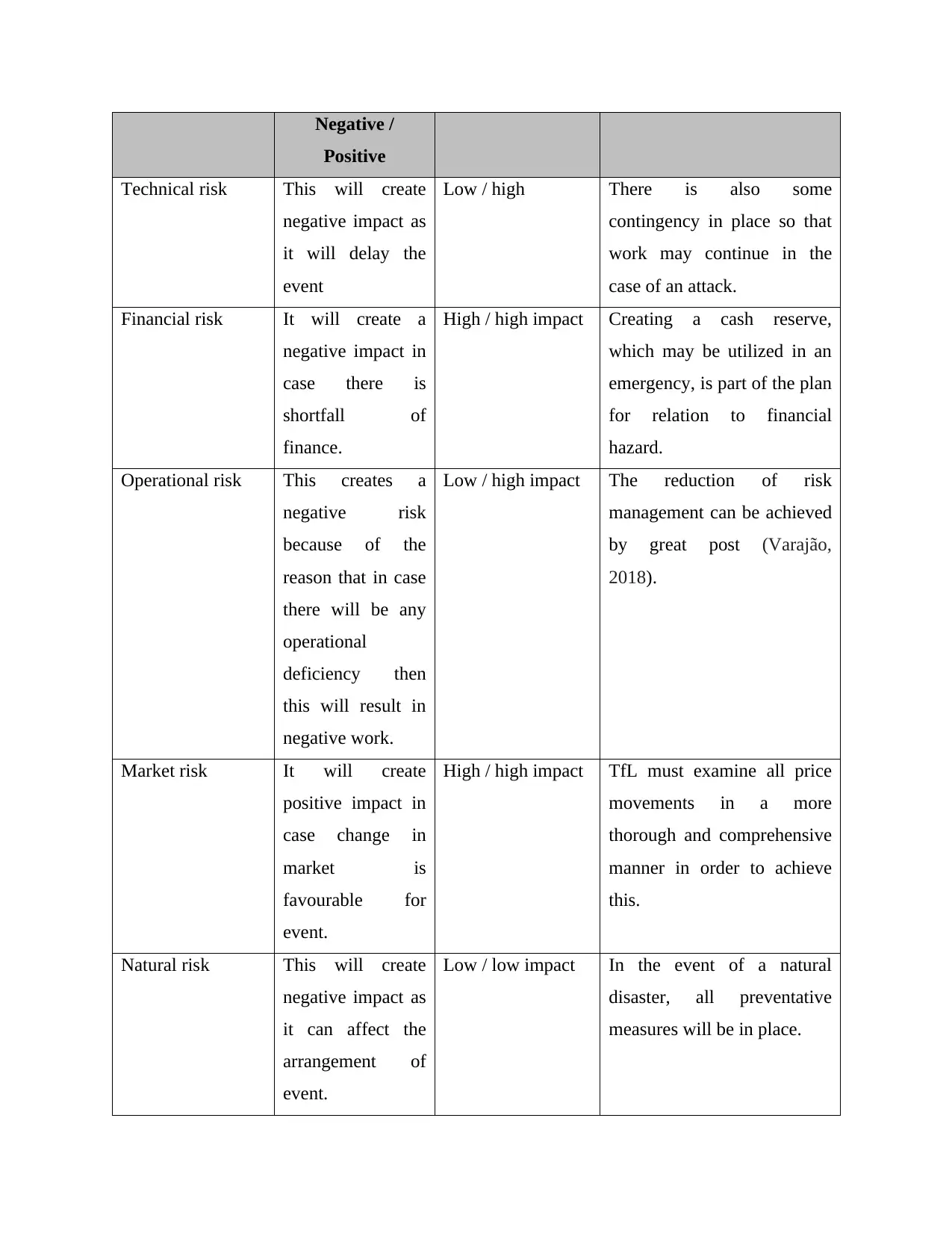
Negative /
Positive
Technical risk This will create
negative impact as
it will delay the
event
Low / high There is also some
contingency in place so that
work may continue in the
case of an attack.
Financial risk It will create a
negative impact in
case there is
shortfall of
finance.
High / high impact Creating a cash reserve,
which may be utilized in an
emergency, is part of the plan
for relation to financial
hazard.
Operational risk This creates a
negative risk
because of the
reason that in case
there will be any
operational
deficiency then
this will result in
negative work.
Low / high impact The reduction of risk
management can be achieved
by great post (Varajão,
2018).
Market risk It will create
positive impact in
case change in
market is
favourable for
event.
High / high impact TfL must examine all price
movements in a more
thorough and comprehensive
manner in order to achieve
this.
Natural risk This will create
negative impact as
it can affect the
arrangement of
event.
Low / low impact In the event of a natural
disaster, all preventative
measures will be in place.
Positive
Technical risk This will create
negative impact as
it will delay the
event
Low / high There is also some
contingency in place so that
work may continue in the
case of an attack.
Financial risk It will create a
negative impact in
case there is
shortfall of
finance.
High / high impact Creating a cash reserve,
which may be utilized in an
emergency, is part of the plan
for relation to financial
hazard.
Operational risk This creates a
negative risk
because of the
reason that in case
there will be any
operational
deficiency then
this will result in
negative work.
Low / high impact The reduction of risk
management can be achieved
by great post (Varajão,
2018).
Market risk It will create
positive impact in
case change in
market is
favourable for
event.
High / high impact TfL must examine all price
movements in a more
thorough and comprehensive
manner in order to achieve
this.
Natural risk This will create
negative impact as
it can affect the
arrangement of
event.
Low / low impact In the event of a natural
disaster, all preventative
measures will be in place.
⊘ This is a preview!⊘
Do you want full access?
Subscribe today to unlock all pages.

Trusted by 1+ million students worldwide
1 out of 17
Related Documents
Your All-in-One AI-Powered Toolkit for Academic Success.
+13062052269
info@desklib.com
Available 24*7 on WhatsApp / Email
![[object Object]](/_next/static/media/star-bottom.7253800d.svg)
Unlock your academic potential
Copyright © 2020–2025 A2Z Services. All Rights Reserved. Developed and managed by ZUCOL.


